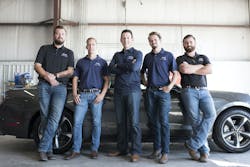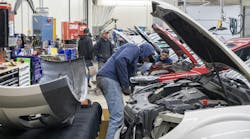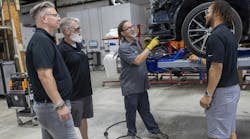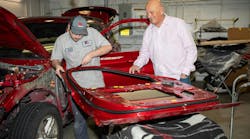The Millennial Shop Owner’s Vision for Collision Repair
Since the day he graduated with his MBA, Kevin Taylor hasn’t bought a pair of dress shoes or slacks.
He has, however, purchased a few pairs of ostrich cowboy boots for nicer occasions; some buffalo and calf boots for casual settings; oh, and if he really wants to pull all the stops, his go-to “fancy” boots are made from the belly of caiman (a South American crocodile).
It’s certainly not traditional dress for a businessman and his employees (who almost all wear cowboy boots, by the way), but then again, very little about Taylor’s Maaco shop in Houston is “traditional.” On the surface, it’s just another Maaco shop—but once you step inside? And once you meet the owner and his staff? And once you realize how streamlined the operations are? The perception changes. This young shop owner is showing that once you stray from the norm and adopt some progressive attitudes about running a business, you’ll stick out like a sore thumb—in a good way.
“Being young, dumb and aggressive probably helped me early on more than I know,” Taylor says. “I didn’t know what to say no to.”
Young, dumb and aggressive—labels Taylor proudly assigns to himself and his crew. That fearless approach to an industry (that he claims is a little “too set in its ways”) is what unites the three shop owners featured in this article, who all want to offer this simple, yet indispensable, piece of advice as your shop heads into the new year: Don’t be afraid of change. Each of these three millennial businessmen stepped into shops that were steeped in tradition, and quickly transitioned those shops into unprecedented territory.
Hopefully, by the time you’ve finished hearing their stories, Taylor hopes “young, dumb and aggressive” won’t sound like a fault—it will become a mantra. It will give you hope about the future leaders of this industry.
SHOP STATS: BOYCE BODY WERKS Location: Two locations in Illinois Employees: 47 Average Monthly Car Count: 245 Annual Revenue: $7.4 million
Always Adapting
by Travis Bean, Melissa Steinken
Kyle Boyce is only one year younger than the shop his family started in 1985.
While he was certainly “born into the industry,” transitioning into a leadership role at Boyce Body Werks has been anything but familiar or intrinsic—if anything, it’s been an intimidating, frustrating, long process.
But not because Boyce wasn’t ready for the collision repair industry—because the industry wasn’t ready for him.
While his parents are still technically majority owners of the two Boyce Body Werks locations in Naperville and Batavia, Ill., Boyce manages all day-to-day operations at this point, and has taken advantage of the complete freedom granted in reshaping processes and management. From an old-school set-up to a new-school revamp, little about Boyce’s $7.4 million shops remains the same month to month—and Boyce Body Werks is thriving because of his team’s ability to constantly adapt.
Learn the Rules, Break the Rules
Boyce worked in his family business as a painter for around five years, transitioned into estimating, and then transitioned into accounting—the list goes on. Coming home after school and working for a few hours at the shop became normal, and no department was out of Boyce’s wheelhouse.
Getting a feel for Boyce Body Werks on that multi-layered level, as you can imagine, prepared Boyce for a fairly seamless transition into leadership, as he understood both the shop processes and the players on his team.
And that familiarity also played a huge hand in Boyce’s vision to pivot the shop in a new direction. After spending a year on the road, visiting shops and attending an Axalta Business Council with Mike Anderson, Boyce had not only adopted a copious amount of ideas for fine-tuning operations at his home shop, but dreamt up new ideas that gave traditional processes his own personal touch—learning the rules before he broke them, if you will.
Focused on the small details, Boyce retained his father’s (Ken Boyce) customer-focused principles while shifting those old-school ways to technology-driven processes, and adapted his leadership over time to cultivate a stronger team culture that embraced his forward-thinking agenda. When those two elements are working together, Boyce says his team of 47 employees can handle any issue it encounters and can adapt to any process.
"At the end of the day, when they realize they’re making more money than last year with less hours, that’s a motivating factor"
-Kyle Boyce, manager, Boyce Body Werks
The Gameplan
This past November, when Boyce walked back into his office after an Axalta Business Council meeting, he had a piece of paper with three notes scribbled on it:
- Wrap up all loose ends with OEM certifications.
- Attend more leadership training.
- Revamp administrative bonus plans.
This itemized list is the highlight from what was 10 pages of notes taken at Boyce’s latest regularly scheduled Axalta meeting, which help him stay on top of current trends practiced by industry leaders.
“The most successful shops in the county are having the same issues I’m having,” he says. “I like that I can bounce ideas off them.”
In those 10 pages of notes, Boyce has learned that most items must fit into a larger game plan, but in the short term, adapting to new processes and forcing change in the shop can point everyone down a more profitable path.
And two years ago, one of Boyce’s game-changing moments came in the form of one of those short-term ideas—an idea his team is still perfecting to this day.
The Assembly Line
For 33 years, the body techs managed themselves at Boyce Body Werks, Boyce says. And while that system certainly has its place, Boyce envisioned a 100 percent streamlined, hiccup-free approach to scheduling and repairing vehicles, which his small administrative staff couldn’t offer his individual system. And with only one DRP on the shop’s account, the amount of paid-for work and supplements was starting to overwhelm the entire repair process.
That’s why, after visiting numerous shops across the country, Boyce switched his team from an individual, every-man-for-himself process to an assembly line–type process. His body shop teammates went from purely body technicians to filling out roles in the newly established disassembly, blueprinting, body and reassembly segments.
While certainly not a groundbreaking set-up, it was a transition for Boyce’s seasoned technicians, some of whom had worked under his father for over 10 years. But when Boyce presented the changes, he wasn’t just introducing a new process—he was positioning it as a way of becoming more productive and achieving a more fulfilling career.
“At the end of the day, when they realize they’re making more money than last year with less hours, that’s a motivating factor,” he says.
So that was the mentality: work less, make more money. And to make more money, it required across-the-board cooperation and constant adaptation. At morning meetings, Boyce and his team review the repair process and find new ways to streamline procedures and get cars out faster while retaining their quality standards.
“They come up with quite a few ideas to make changes,” he says. “They’ll buy into their own ideas more.”
While his team is “still dialing in” the new team process, they will always, in a sense, be dialing it in, as it’s constantly shape shifting and improving. Technicians will often move between different stages of the repair to where they’re suited best. At first, Boyce started observing and getting to know his team before transitioning the process over.
“It takes time,” he says. “You definitely have to pay attention to what keeps them interested and learning their style.”
The actual orientation of each department on the shop floor is prone to movement as well. Just last month, the reassembly and disassembly departments swapped spots once a reassembly technician realized being near the parts room cut down on walking distance, boosted productivity and improved communication.
At first, Boyce tried out the team system in just one of the shops; today, with the Naperville location doubling in size to 17,000 square feet, he’s smoothly implemented the process at both locations with little to no disruption. As a result, annual revenue has risen by 24 percent in the past two years to $4.2 million, and cycle time in the last year dropped almost 48 hours to an average of six days.
Switching the team processes took two years to develop strategy and layout, he says.
Boyce has shifted the shop’s motto on quality to focusing on being the best. While his dad was running the shop, he says, the team and customers operated under the assumption that quality takes time to produce. Now, Boyce follows the assumption that all the shop’s competition has great quality. The shift in mindset forced Boyce to shift the shop’s processes to cut down on time.
STATS: FULL TILT AUTO BODY Location: Easthampton, Mass. Employees: 13 Average Monthly Car Count: 60 Annual Revenue: $1.9 million
Standing Out From the Crowd
by Noura Elmanssy, Melissa Steinken
One brother worked in a body shop as a painter at the age of 18; the other brother was a special education teacher.
Separately? Their careers were heading in wildly different directions.
Together? This dynamic duo now manages a $1.9 million shop, leading a staff of mostly millennials ranging from 28–53 years old.
Zac and Matt Ciaschini may not have known everything about the collision repair industry when they opened Full Tilt Auto Body in Easthampton, Mass., but what they did know was that a youthful, progressive vibe would make their shop stand out in the community.
And to stand out from the typical family shop, the two tapped into what they say many shops fail to utilize effectively: Facebook, of course.
With a majority of their marketing focused around Facebook and the local papers, the two brothers say they’ve found the key to building close relationships with the members of their community—which they believe separates them from the age-old traditions to which collision repair customers have grown accustomed.
A Refreshing Brand
“Your car, your choice.”
That’s how the saying goes at Full Tilt. Don’t let the insurance companies dictate who fixes your car, and don’t be afraid to ask questions—at the Ciaschinis’ shop, Matt and Zac want you, the customer, to have a say in the repair process. With the brothers’ brand, all ego is stripped away, and they want to reflect that you have control over your own vehicle.
When it came time for Zac (who founded the business in 2008 and was later joined by Matt in 2010) to choose a name for his shop, he spent a significant amount of time trying to find a name that immediately communicated the shop’s values.
So, instead of going with something ordinary like “Ciaschini Auto Body,” the two decided on Full Tilt. Clean, sharp and simple—a modern take for a modern shop that has aspirations that stray from the norm.
The logo was the first step in really creating their brand. The brothers began by recruiting a friend in advertising to help create a logo, eventually designing the now retro-themed “FT” design.
The Full Tilt logo is red on black, made to look like an inked design over black speckled paint. The brothers are now redesigning their website for an updated look on their already cohesive style.
But being young has given them another great advantage: the ability to personally connect with the much sought-after, much misunderstood younger demographic.
It’s that younger crowd that loves social media.
Facebook—the New Wave of Marketing
Capitalizing on Zac’s large friend group on Facebook, it was quite easy for the shop to get an initial following.
“The absolute biggest thing that has kind of catapulted us was using Facebook early on,” Matt says.
And that simple move got the brothers thinking: Instead of parents telling their kids where to get their car done, those kids can just find the shop on Facebook instead—a method they’ve seen become massively successful.
It was through Facebook that Matt and Zac were also able to boost their second largest marketing channel: local paper polls.
Two publications in the area conduct business polls that consist of hundreds of business categories. By simply asking their customers to vote for their shop, Full Tilt has won first place in the auto body category in both publications for the last five years.
But creating a customer base wasn’t the only reason the two wanted to utilize Facebook in particular—it was also a great avenue to prevent trolling.
Matt says most of the customers that leave online reviews of the business do it through Facebook. It’s much more effective, he says, because whoever is reading the reviews can click on the person’s name, go to their profile and see that they’re a real person, which he believes is more meaningful in winning people over.
Instead of having a nameless and faceless review on Yelp or Google—that sometimes can denounce the business—now, they ask every customer to review them on Facebook because they feel it is much more genuine, Matt says.
Always Ahead
While keeping their marketing social media friendly and personal, the brothers feel investing in technology will only improve efficiency and the bottom line.
The team at Full Tilt relies heavily on an inter-shop email system as a way to communicate throughout the day and stay on top of work. The team starts an email thread for every RO, so all office staff and technicians can communicate seamlessly about every individual vehicle in the shop.
As part of the system, all staff members are required to carry smartphones. If they can’t afford one, the brothers create a personalized plan where they purchase the phone for the staff member and the value is repaid via a weekly stipend.
The smartphones are used for email and the CCC ONE app, a platform the brothers use for estimating, production management and accounting. The phones lend the capability to take photos of the vehicles throughout the process, which all go into the cloud seamlessly, Matt says. Tablets are also located throughout the shop.
But this system is nothing out of the ordinary—they were always ahead of the curve when it came to technology, Matt says. Back in 2012, the shop already took digital photos for their customers, using SD cards that had a Wi-Fi signal. The SD cards allowed the employees to take photos with a digital camera and wirelessly upload them into a folder on the computer so they wouldn’t have to constantly connect the camera.
On all their customer intake forms, the brothers ask customers whether they prefer to be texted, emailed or called—another way to ensure that they can accommodate the customer’s preference.
With connected cars around the corner, vehicles are on the verge of forming a more intimate relationship with drivers—including telling them where they should get their cars fixed, Matt says. That’s why, in the end, a focus on technology and a “your car, your choice” brand is what will set the Ciaschinis apart.
“If your shop isn’t staying on top of technology, you will fall behind,” Matt says.
STATS: MAACO COLLISION REPAIR & AUTO PAINTING Location: Houston Employees: 23 Average Monthly Car Count: 140 Annual Revenue: $2.5 million
Flipping the Script
by Noura Elmanssy
At 24 years old, Kevin Taylor earned his MBA.
At 24 years old, Taylor thought he was going to be on Wall Street.
At 24 years old, Taylor saw no future for himself in the collision repair industry.
And at 27 years old, Taylor purchased his own body shop.
If it wasn’t for his “young, dumb and aggressive” mentality, Taylor wouldn’t be where he is today. While helping his dad manage a Maaco shop as he initiated a career in the finance field, he couldn't help but feel his calling was in another field.
“I was in brokerage, packing real estate deals and selling them off out of grad school,” he says. “But I learned I did not like working for a big company.”
So, in turn? The body shop—which he had previously figured was an “undesirable industry”—suddenly made sense.
Starting with his dad’s shop in 2005, where he tested the water and made changes like tracking estimates versus retention and a shift in focus on ARO, car count and fleet opportunities—he doubled the shop's sales within two years from $500,000 to $1 million.
He came to find that he had more of a voice, led a smaller team, and his decisions had a business-wide impact.
When presented with an opportunity of turning around an underperforming Maaco shop, despite some risky leaps and bounds, he decided to take them head on.
He’d safely argue that, today, that was a good decision. The now-owner of a Maaco facility in Houston, Taylor went from thinking the collision industry was “dirty” to now running a $2.5 million facility—all while remaining one of the youngest Maaco shop owners in the country at 36 years old. And he did that by flipping the Maaco formula and image to stand out from the crowd.
Combating the Maaco Way
In 2010, Taylor purchased a large underperforming shop, which boasted 18,000 square feet in workspace, but only churned out $700,000 in annual revenue.
And while the turnaround seemed daunting, Taylor had only one key goal in mind with that purchase—a goal that seems absurd, delusional and unrealistic.
Well, it seems absurd, delusional and unrealistic, until you remember how Taylor operates.
“From the beginning, I wanted to have the best shop in the country. Period,” he says. “I want the best shop in every way. Process, quality, cycle time, profit, everything—I want everything.”
And the business Taylor was purchasing wasn’t just any old shop—it was a Maaco facility. But Taylor knew what he was getting into when he decided to go for a Maaco shop. He knew he liked the retail focus of the company, along with:
- The purchasing power and ownership infrastructure
- Branded advertising and purchaser advertising at a discounted rate.
- The opportunity for networking.
Taylor also knew what he didn’t like. He says the Maaco brand is inaccurately associated with cheap painting, poor workmanship, underwhelming facilities and remedial technology.
“I said if I was going to do this, I didn’t want to be like that,” he says.
It all started with looks. Taylor has renovated twice in the last six years. He invested in state-of-the-art, HD LED screens, brand new welders, laser frame equipment and frame machines and restructured the back of his facility.
Next was finding the balance between doing the $700 paint jobs that Maaco was known for and knowing how to properly repair a $5,000 front-end job, he says.
“When we make a mistake and we’re a Maaco, we have a very short leash for customer confidence,” he says.
Taylor knew certification was going to set him apart and boost customer trust, so he was one of the first shops in the country to jump on the Maaco Certified Program. In addition, his shop and each one of his techs became I-CAR Gold certified, which is not common among Maaco shops, he says.
The Unexpected Turn
Sure, Taylor had turned around his dad’s shop once before. But turning it around a second time was the last thing he expected three years after striking out on his own and purchasing his Maaco shop. That is, until the life-altering events of Christmas Eve 2012, when Taylor’s dad was shot in the parking lot of his shop by the suspect of a high-speed car chase.
In the aftermath of the event, Taylor had to look after the business, and while he had been going there every week anyway to help out, this time he really had to prepare the business for sale, something his mother wanted to do.
Unfortunately, in the years since Taylor moved on from running the shop on a day-to-day basis, his father’s sales had declined again. So, Taylor applied the same methods that he did the first time around to increase sales once again by 50 percent.
Taking care of both his own and his dad’s shop proved challenging for Taylor, and he soon realized that he couldn’t grow the quality and the revenue of his shop if he continued to focus on both.
“I didn’t feel like it was a good fit at the time. I didn’t feel that my shop was the best shop in the country yet and that was my focus,” he says.
After prepping the family shop operationally, he then sold it to an individual who then sold it to an MSO.
But it was through this experience that he tapped into the support system he had around him, including fellow Maaco shop owner, Brian Greenley, owner of one of the most successful Maaco franchises in company history.
Taylor flew out to Greenley’s Littleton, Colo., shop and the two clicked immediately. Taylor describes it as being “on the same wavelength” in nearly every aspect of business, including their remarkably similar management styles.
His mentor/mentee relationship with Greenley reassured Taylor that his decision to stray from the crowd meant that he was doing something right.
The "Kevin Way"
Since then, Taylor has become laser focused on putting out quality work in a timely fashion that’s profitable to the business and of value to the customers—that’s the “Kevin Way.”
“If we don’t have all of those, it doesn’t work,” he says.
In order to achieve this, he started with the staff. Upon purchase of the shop, Taylor made everyone reapply for their jobs to ensure that he had the right staff in place, and, of course, added some new members.
“I wanted good people. I wanted people that had a built–in sense of urgency and people that wanted to learn and to be better every day. We wanted to continuously make improvements all the time,” he says.
He took people from industries such as the insurance, restaurant, construction and commercial maintenance businesses and trained them from the ground up. Everything from the basics of how to talk to a customer, to the difference between insurance and out-of-pocket repairs, to the parameters of a customer negotiation, are all addressed in training.
“I took non-industry guys and I trained them to be 'Kevin’s Guys,'” he says.
Using his business background, he’s given accounting and business classes to his staff to help them in their personal and professional lives. This practice has helped retain 80 percent of the crew over the past four years.
To ensure a teamwork mentality, Taylor says his staff is salaried with the opportunity for bonuses based on what the shop makes.
In the beginning, he saw all of his business opportunities in local and national fleets. He realized those customers were being “kicked to the curb” by other shops because of DRP relationships. When everyone was going in the direction of DRPs, Taylor remembers going against the grain and maximizing fleet opportunities.
While a “non-DRP” mentality is not uncommon in most Maaco shops, for Taylor’s production-focused model instead of a retail focused, his reasoning for remaining solo is so pointedly representative of his leadership style and progressive vision that it almost feels entirely unique.
“I control what we do—we drive the train, and I’m the conductor,” he says. “We have a background for being young, progressive and growing. My crew knows our objectives. I’ve had to focus on that hard to lead in the right direction.”



